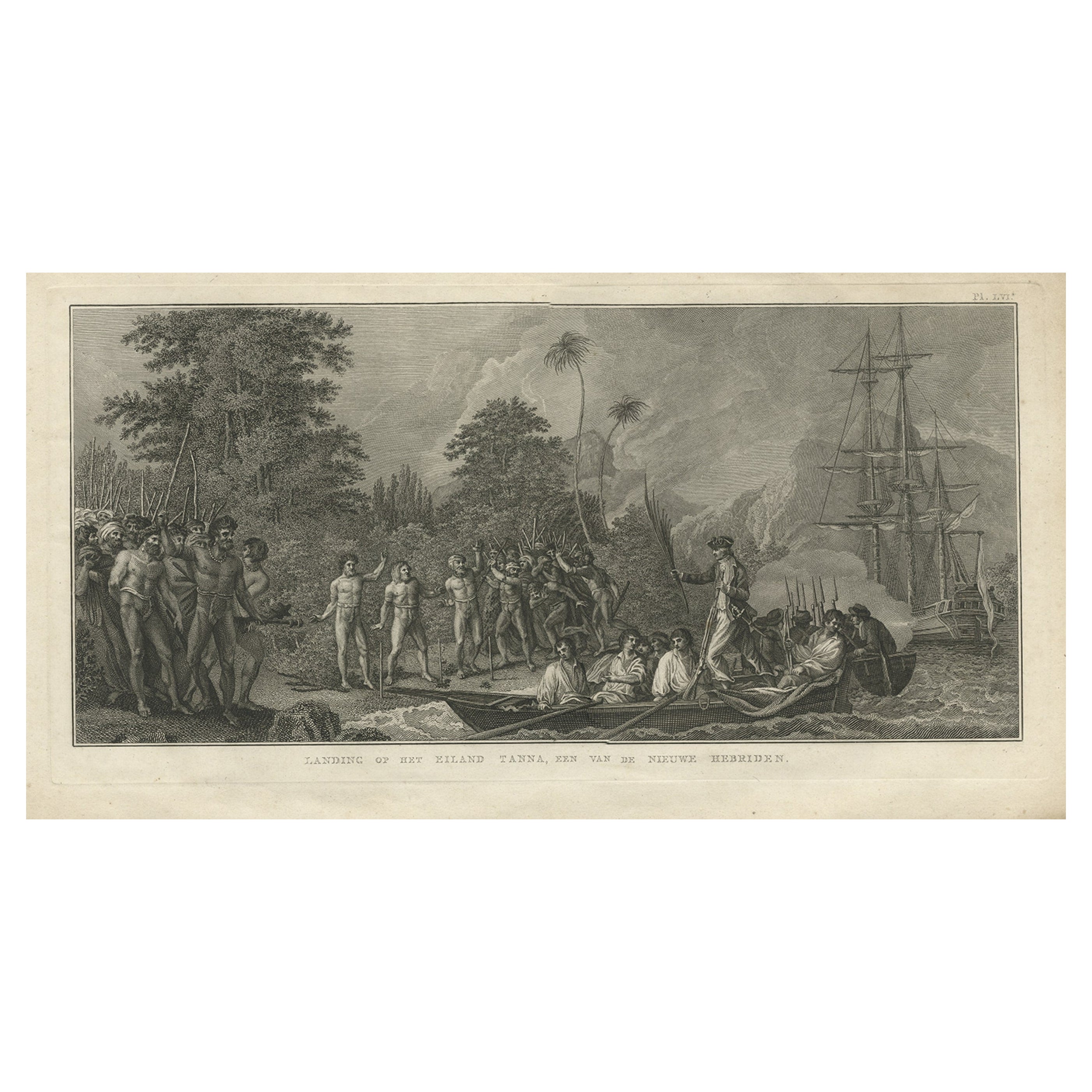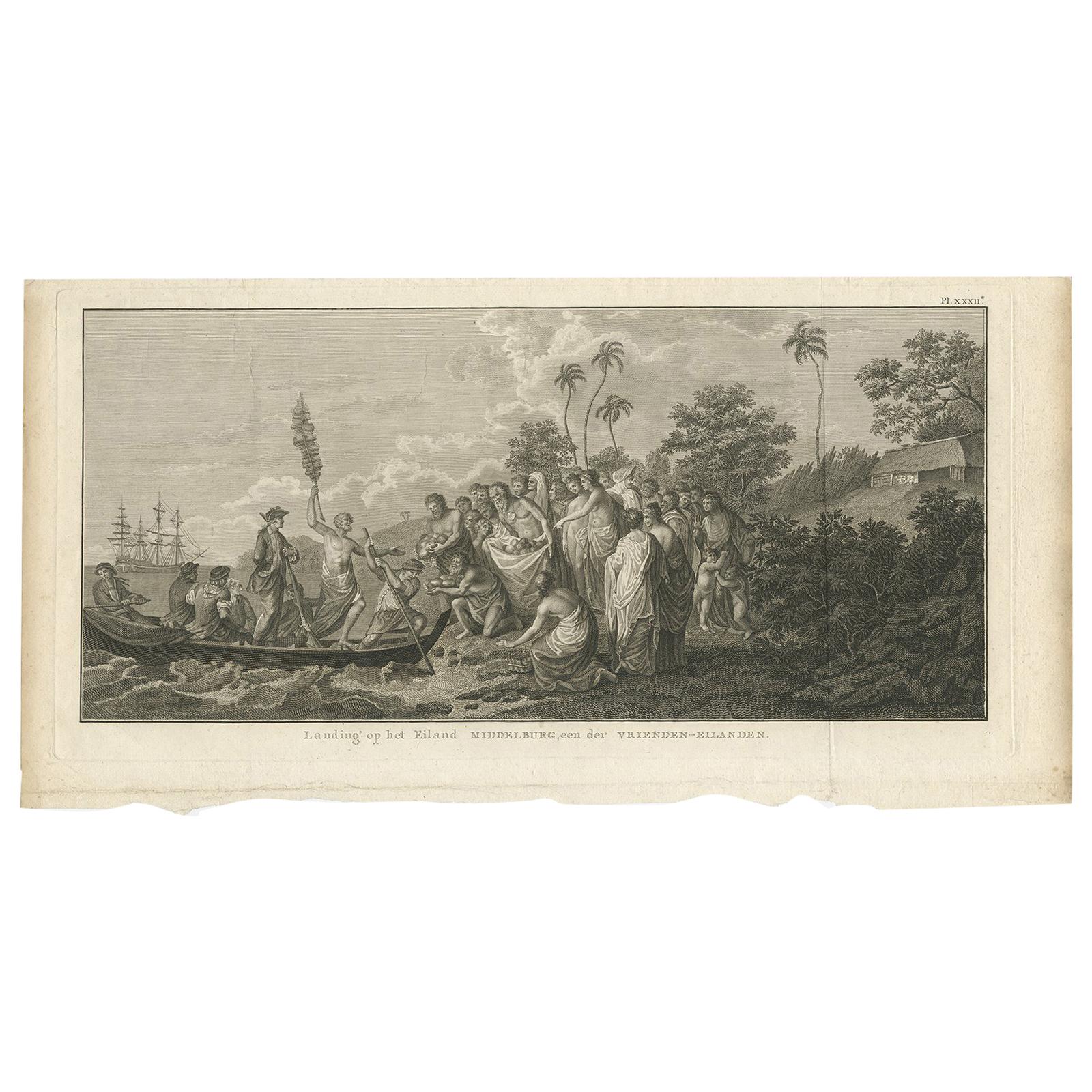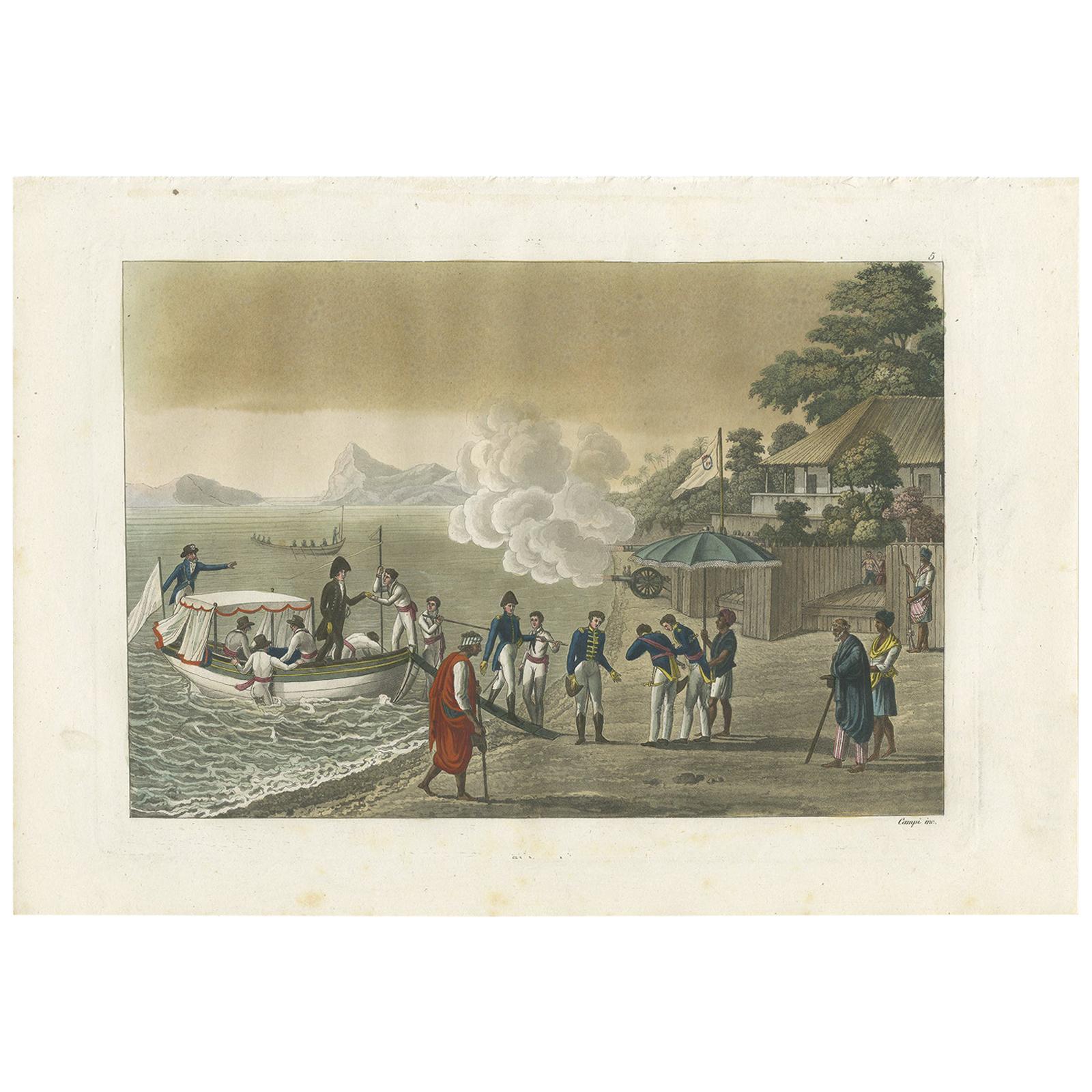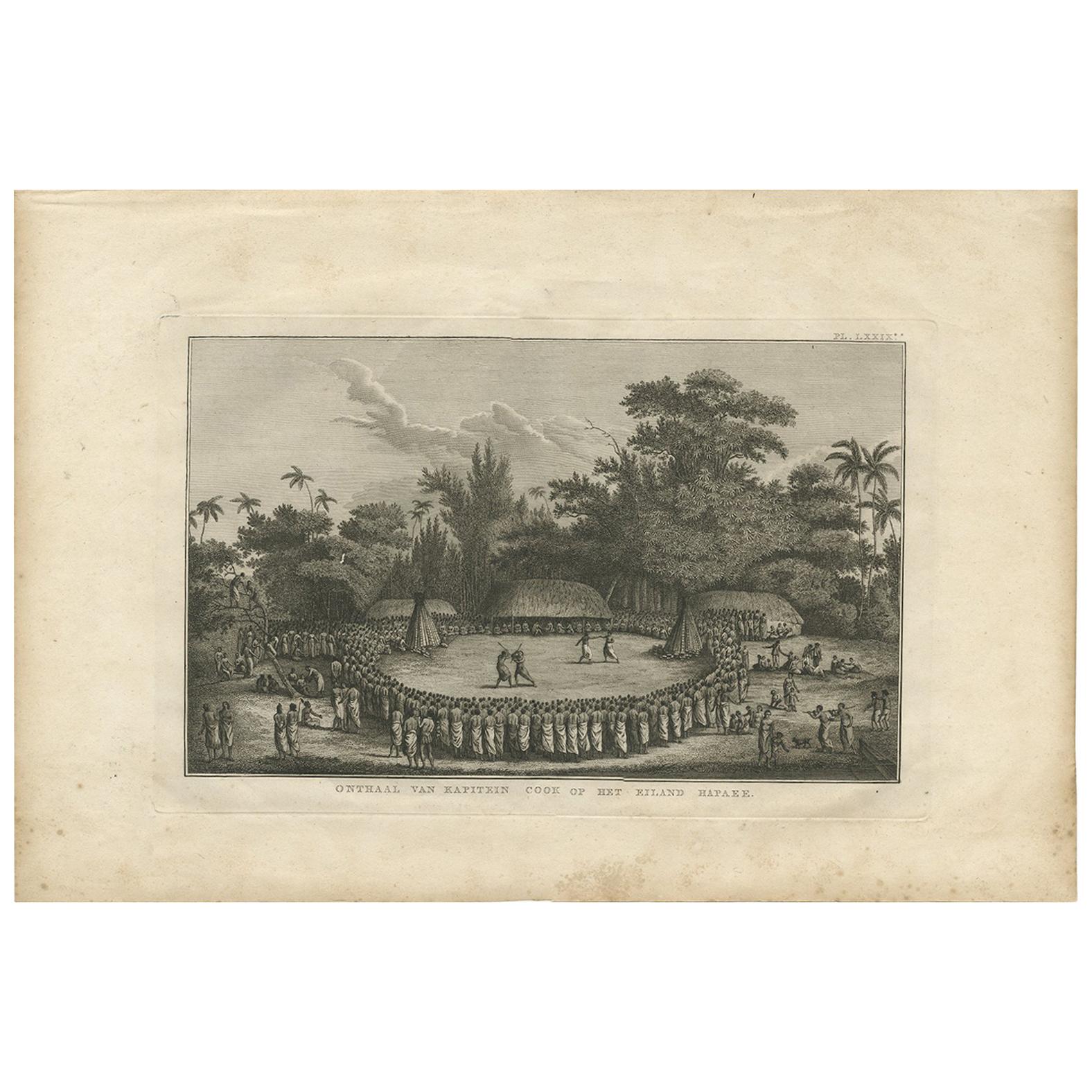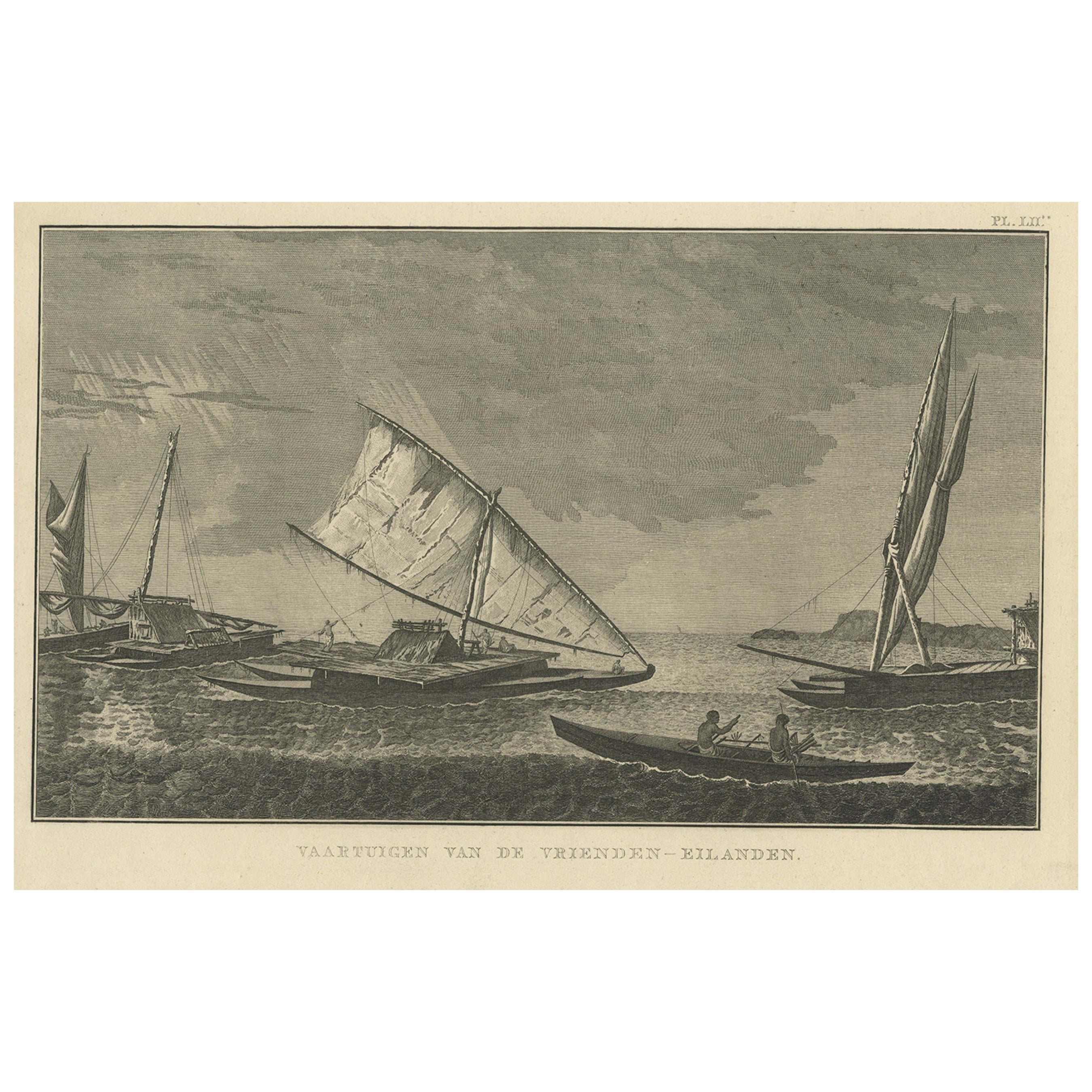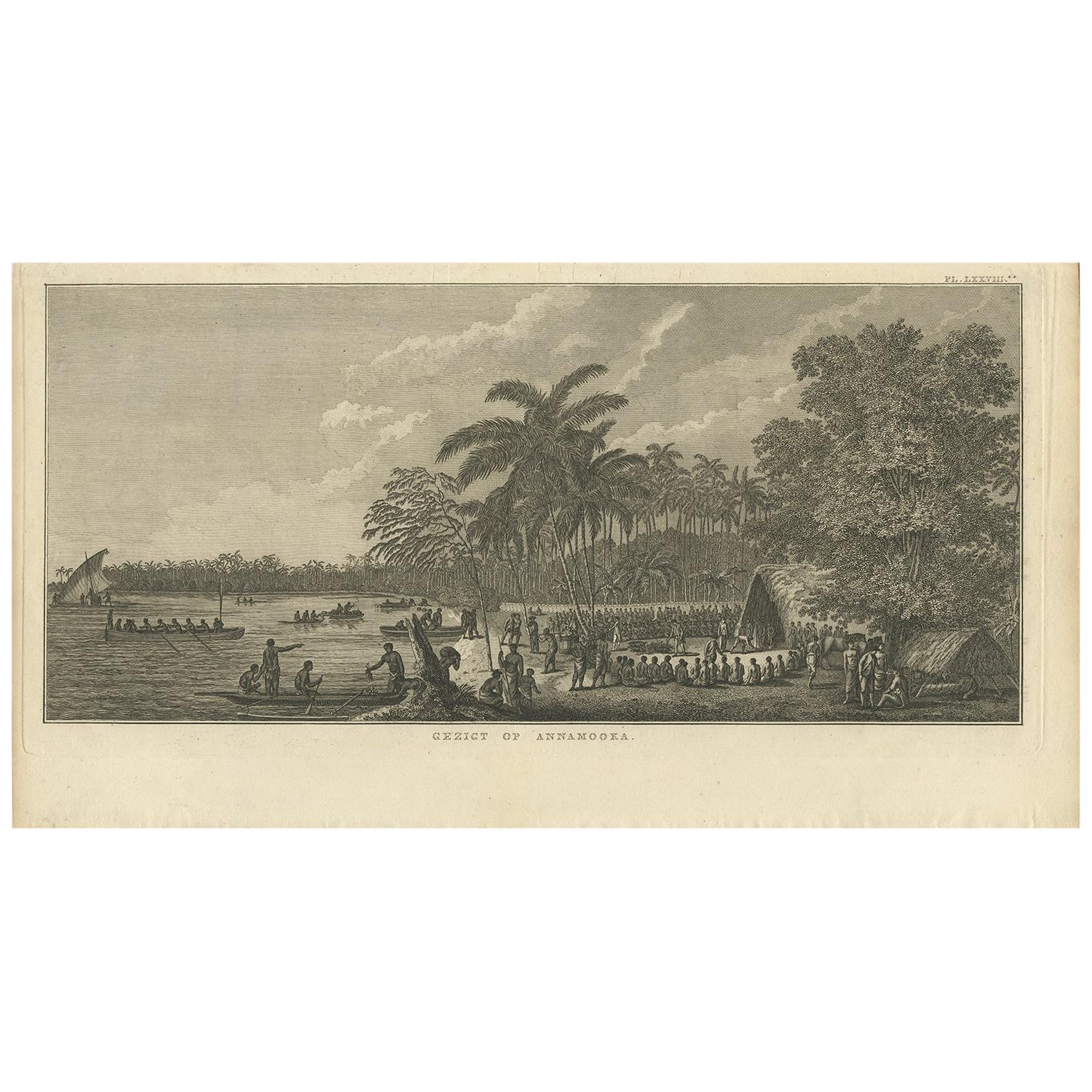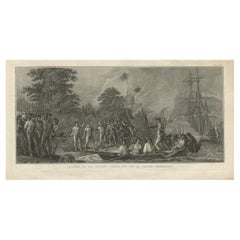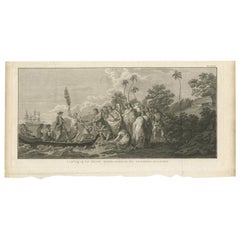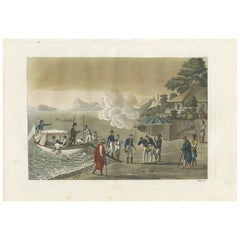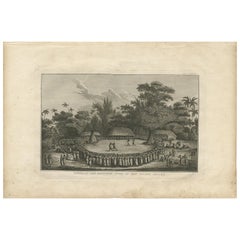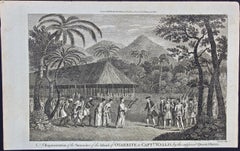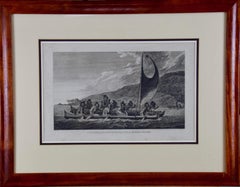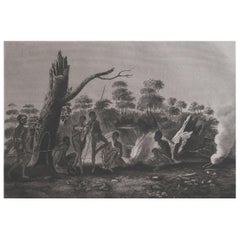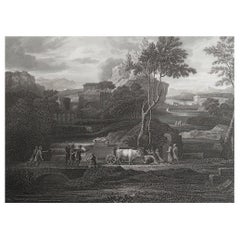Items Similar to Antique Print of the Landing at Malakula Island, Vanuatu, by Cook, 1803
Want more images or videos?
Request additional images or videos from the seller
1 of 5
Antique Print of the Landing at Malakula Island, Vanuatu, by Cook, 1803
$277.38
$346.7320% Off
£205.35
£256.6820% Off
€232
€29020% Off
CA$383.83
CA$479.7920% Off
A$423.16
A$528.9520% Off
CHF 221.38
CHF 276.7320% Off
MX$5,191.41
MX$6,489.2720% Off
NOK 2,786.80
NOK 3,483.4920% Off
SEK 2,606.09
SEK 3,257.6220% Off
DKK 1,767.23
DKK 2,209.0420% Off
About the Item
Antique print New Hebrides titled 'Landing op het Eiland Mallicolo, een van de Nieuwe Hebriden'. Antique print depicting the landing at one of the islands of the New Hebrides, Vanuatu. Originates from 'Reizen Rondom de Waereld door James Cook (..)'.
Artists and Engravers: Translated by J.D. Pasteur. Published by Honkoop, Allart en Van Cleef.
Condition: Good, age-related toning. Some creasing and marginal tears. Please study image carefully.
Date: 1803
Overall size: 52.5 x 27.5 cm.
Image size: 45 x 20.5 cm.
Whilst cartography holds a special place in our collection, we also offer thousands of antique prints covering fields of interest as diverse as architecture, natural history, religion, ethnology and many more. Antique prints have long been appreciated for both their aesthetic and investment value. They were the product of engraved, etched or lithographed plates. These plates were handmade out of wood or metal, which required an incredible level of skill, patience and craftsmanship. Whether you have a house with Victorian furniture or more contemporary decor an old engraving can enhance your living space. We offer a wide range of authentic antique prints for any budget.
- Dimensions:Height: 10.83 in (27.5 cm)Width: 20.67 in (52.5 cm)Depth: 0 in (0.01 mm)
- Materials and Techniques:
- Period:
- Date of Manufacture:1803
- Condition:Condition: Good, age-related toning. Some creasing and marginal tears. Please study image carefully.
- Seller Location:Langweer, NL
- Reference Number:Seller: BG-11487-671stDibs: LU3054327830682
About the Seller
5.0
Recognized Seller
These prestigious sellers are industry leaders and represent the highest echelon for item quality and design.
Platinum Seller
Premium sellers with a 4.7+ rating and 24-hour response times
Established in 2009
1stDibs seller since 2017
2,613 sales on 1stDibs
Typical response time: <1 hour
- ShippingRetrieving quote...Shipping from: Langweer, Netherlands
- Return Policy
Authenticity Guarantee
In the unlikely event there’s an issue with an item’s authenticity, contact us within 1 year for a full refund. DetailsMoney-Back Guarantee
If your item is not as described, is damaged in transit, or does not arrive, contact us within 7 days for a full refund. Details24-Hour Cancellation
You have a 24-hour grace period in which to reconsider your purchase, with no questions asked.Vetted Professional Sellers
Our world-class sellers must adhere to strict standards for service and quality, maintaining the integrity of our listings.Price-Match Guarantee
If you find that a seller listed the same item for a lower price elsewhere, we’ll match it.Trusted Global Delivery
Our best-in-class carrier network provides specialized shipping options worldwide, including custom delivery.More From This Seller
View AllAntique Print of the Landing at Tanna Island by Cook, 1803
Located in Langweer, NL
Antique print New Hebrides titled 'Landing op het Eiland Tanna, een van de Nieuwe Hebriden'. Antique print depicting the landing at one of the islands of the New Hebrides, Vanuatu. O...
Category
Antique 19th Century Prints
Materials
Paper
$516 Sale Price
20% Off
Antique Print of the Landing at Middelburg Island by Cook, 1803
Located in Langweer, NL
Antique print titled 'Landing op het Eiland Middelburg, een der Vrienden-Eilanden'. Print depicting the landing at Middelburg Island, one of the Friendly Islands. Originates from 'Re...
Category
Antique Early 19th Century Dutch Prints
Materials
Paper
$191 Sale Price
20% Off
Antique Print of the Landing of French Troops on Timor by Ferrario, 1831
Located in Langweer, NL
Original antique print of the landing of French troops on Timor island. This print originates from 'Costume Antico e Moderno: Palestine, China, India, Oceania' by Ferrario. Published...
Category
Antique Mid-19th Century Prints
Materials
Paper
$239 Sale Price
20% Off
Antique Print of the Arrival of Captain Cook, 1803
Located in Langweer, NL
This antique print depicts the ceremonial welcome received by Captain James Cook upon his arrival at the island of Hapaee (Ha’apai) in Tonga during his third voyage in 1777. The engr...
Category
Antique Early 19th Century Dutch Prints
Materials
Paper
$191 Sale Price
20% Off
Antique Print of Boats of the Friendly Islands or Tonga, by Cook, c.1801
Located in Langweer, NL
Antique print titled 'Vaartuigen van de Vrienden-Eilanden'. This print depicts various boats. Originates from 'Reizen rondom de Waereld' by J. Cook.
Artists and Engravers: Author:...
Category
Antique 19th Century Prints
Materials
Paper
$267 Sale Price
20% Off
Antique Print of Annamooka, Tonga Islands, by Cook '1803'
Located in Langweer, NL
Antique print titled 'Gezigt op Annamooka'. This print depicts the Harbour of Annamooka, now Nomuka, part of the Ha’apai group of Tonga. Originates from 'Reizen rondom de Waereld' by...
Category
Antique Early 19th Century Dutch Prints
Materials
Paper
$358 Sale Price
20% Off
You May Also Like
Surrender of Tahiti to Captain Wallis: An Original 18th C. Engraving
By John Webber
Located in Alamo, CA
"A Representation of the Surrender of the Island of Otaheite to Capt.n Wallis, by the Supposed Queen of Oberea" is an original 18th century engraving created by Sparrow, from a drawi...
Category
1780s Landscape Prints
Materials
Engraving
Sandwich Islands Canoe (Hawaii): Framed 18th C. Engraving Captain Cook's Journal
By John Webber
Located in Alamo, CA
"A Canoe of the Sandwich Islands, the Rowers Masked" is an engraving created by Charles Grignion, from a drawing by John Webber (1752-1793), who was the artist on Captain James Cook's 3rd and final voyage of discovery. It is Plate 65 in the atlas of "A Voyage to the Pacific Ocean Undertaken by the Command of His Majesty, for Making Discoveries in the Northern Hemisphere", the official British Admiralty sanctioned journal published upon completion of the voyage in London in 1784 by Strahan & Cadell.
This famous image of ten Hawaiian rowers transporting a priest who is carrying a feather-covered image of Kukailimoku, the Hawaiian god of war. The priests and paddlers are all wearing gourd masks in their double-hulled canoe with an upright lateen woven sail. Each hull was shaped from a single large Koa log harvested from island rainforests, where they were carved before being transported to the coast.
This engraving is presented in a Koa wood frame and a white mat. There are occasional faint spots, but the print is otherwise in very good condition. Koa is the same wood as was used to make the canoe. Koa wood is legendary in Hawaii. Not only is this amazing wood native to Hawaii, but it is known for the deep rich colors and varied grain pattern. Koa has an honored heritage in Hawaii and is highly revered and sacred. The word “koa” means “warrior” in Hawaiian. The warriors of King Kamehameha the Great, created canoes and weapons from a wood plentiful on the Big Island of Hawaii. This wood became synonymous with the warriors themselves, and it became known as koa. The frame measures 20.75" high, 26.75" wide and 0.88" deep.
There are three other engravings listed from the official journal of Captain Cook's 3rd voyage available that are presented in identical Koa wood frames and mat (LU117324682022, LU117324684052, LU117324684062). They would make a wonderful grouping for a display of 2, 3 or 4 prints. A discount is available for a grouping depending on the number of items included.
Hawaii was discovered by Captain Cook (1728-1779) during this voyage. Hawaii was originally called The Sandwich Islands in honor of The Earl of Sandwich...
Category
1780s Landscape Prints
Materials
Engraving
Original Antique Ethnographical Print, Figures, New South Wales, Australia, 1809
Located in St Annes, Lancashire
Wonderful ethnographical print.
A copper-plate engraving after Lesieur
Published by Sherwood, Neely & Jones. Dated 1809
Unframed.
Category
Antique Early 1800s English Folk Art Prints
Materials
Paper
Original Antique Print of The Return of The Ark After Sebastien Bourdon. C.1850
Located in St Annes, Lancashire
Great image after Sebastien Bourdon
Fine steel engraving
Published circa 1850
Unframed.
Free shipping
Category
Antique 1850s English Renaissance Prints
Materials
Paper
Antique Print Lord Nelson On Board The San Joseph
Located in Bridgeport, CT
Hand colored engraving depicting Lord Nelson receiving the Spanish admiral's sword on board The San Joseph from the battle of St. Vincent's. The print with certification adhered to v...
Category
Antique 19th Century English Georgian Prints
Materials
Glass, Wood, Paper
"King of the Friendly Islands" (Tonga); Engraving from Captain Cook's 3rd Voyage
By John Webber
Located in Alamo, CA
"Poulaho, King of the Friendly Islands, Drinking Kava" is an engraving created by William Sharp (1749-1824), from a drawing by John Webber (1752-1793), who was the artist on Captain James Cook's 3rd and final voyage of discovery. It was published in the atlas of "A Voyage to the Pacific Ocean Undertaken by the Command of His Majesty, for Making Discoveries in the Northern Hemisphere", the official British Admirality sanctioned journal published upon completion of the voyage in London in 1784 by Strahan & Cadell.
Captain Cook visited Tonga on his 3rd voyage, which he named The Friendly Islands because of the warm welcome he and his crew received, unlike some of the other more hostile Pacific islands. The engraving depicts Cook and his men observed a kava ceremony at the village of Mu’a on Tongatapu. King Paulaho sits in the centre foreground, his back to the spectator with a man kneeling before him. The ceremonial mat depicted behind Paulaho indicates that nobody was allowed to sit behind him. The figure in the centre holds a single cup, referring to the Tongan custom of offering the cup to the king first. Kava is native to the islands of the South Pacific and was first described for English readers in 1768 by Captain James Cook. The kava root has been used for centuries as a central feature of ceremonies and celebrations because it was able to bring about a calming and pleasant social atmosphere. The root was crushed and processed into coconut milk to become the focal ceremonial beverage, simply referred to as kava.
This engraving is presented in a Koa wood frame and a white mat. Koa wood is legendary in Hawaii. There are occasional faint spots, but the print is otherwise in very good condition. This amazing Koa wood is native to Hawaii and it is known for the deep rich colors and varied grain pattern. Koa has an honored heritage in Hawaii and is highly revered and sacred. The word “koa” means “warrior” in Hawaiian. The warriors of King Kamehameha the Great, created canoes and weapons from a wood plentiful on the Big Island of Hawaii. This wood became synonymous with the warriors themselves, and it became known as koa.
There are three other engravings listed from the official journal of Captain Cook's 3rd voyage available that are presented in identical Koa wood frames and mats (LU117324682422, LU117324684052, LU117324684032). They would make a wonderful grouping for a display of 2, 3 or 4 prints. A discount is available for a grouping depending on the number of items included.
Captain Cook is remembered as one of the greatest explorers and navigators in history. His explorations included Australia, New Zealand and islands of the South Pacific and the northwest coast of North America. Hawaii was discovered by Captain Cook during this voyage. Hawaii was originally called The Sandwich Islands in honor of The Earl of Sandwich...
Category
1780s Realist Figurative Prints
Materials
Engraving
More Ways To Browse
Picasso Nu De Dos
Piranesi Folio
Pour Robie
Robert E Marx
Shepard Fairey 2001
Sonny Zoback
Stained Glass Fairy
Superstudio Lithograph
Tretchikoff Vintage Prints
Trowbridge Gallery Print
Victor Ostrovsky
Vintage Maio Prints
Vintage Puppet Theater
Volkamer Prints
W Dendy Sadler
Werner Graeff
Woodblock Crow
Woodville Prints
